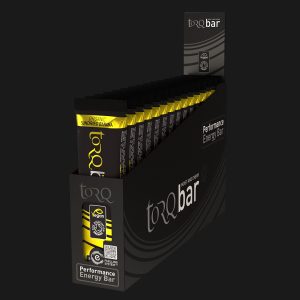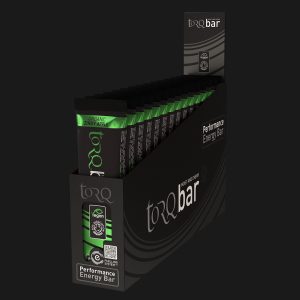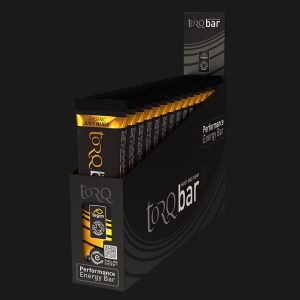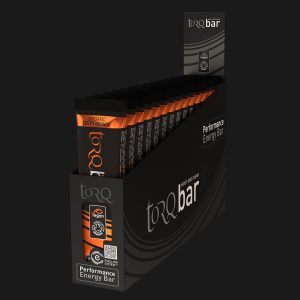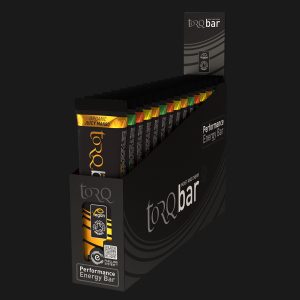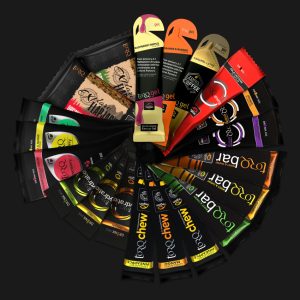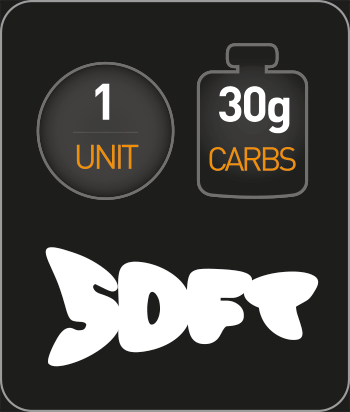Energy Bars
TORQ Bar is an organic ultra-low fat moist and chewy energy bar, formulated to deliver TORQ's unique blend of multiple-transportable carbohydrates to the working muscles quickly and efficiently. TORQ Bar forms part of the TORQ Fuelling System.
Showing all 7 results
Product Highlights
- Multiple Transportable Carbohydrates
- Moist and Chewy
- Very Low in Fat
- Organic Certification
- Fairly Traded Fruit*
- Part of the TORQ Fuelling System
*Except Orange Flavour
Product Summary
Our TORQ Bar was the first performance product we ever produced (back in 2003) and recently we have evolved the recipe so that all of the new wave of TORQ bars are certified Organic by the Soil Association. All TORQ Bars, aside from the orange flavour bar also utilise fairly-traded fruit.
TORQ Bar forms part of the TORQ Fuelling System, so can be used alongside TORQ’s energy drinks, gels and jellies to fuel optimal performances. Please take the time to read about the TORQ Fuelling System by clicking HERE and ensure that you get the most out of this product.
Each TORQ Bar provides 30 grams of multiple-transportable carbohydrates (1 TORQ Unit). For optimal performances, our TORQ Fuelling System recommends consuming 2-3 TORQ Units per hour which can be achieved through consuming a variety of fuelling products as illustrated in the table below. Consuming a TORQ Bar is simply one method of ingesting a TORQ Unit.

The higher your perspiration rates, the more TORQ Energy Drink you will need to consume relative to our more concentrated fuelling units – TORQ Bars, TORQ Gels and TORQ Jellies. All of our fuelling products are optimised with multiple-transportable carbohydrates, the only difference between them is the texture; Smooth, Soft or Chewy. Again, this interaction between TORQ’s fuelling products is explained fully HERE on our Fuelling System page and the illustration below summarises the concept nicely.

Product Usage
TORQ Bar is available in single 45g bars and boxes of 15 (15 X 45g). Sample Packs are also available and you can also build a Mixed Flavour Box on this website.
Each TORQ Bar contains 30g of multiple-transportable carbohydrates.
The TORQ Fuelling System page of this website clearly explains how TORQ Bar works alongside TORQ’s other fuelling products (TORQ Energy Drink, TORQ Gel and TORQ Jellies). We believe TORQ Bar to be the softest, most easy-to-eat energy bar on the market, making it extremely easy to consume whilst exercising. Having said this, there is no quicker way to consume 30 grams of carbohydrate (1 TORQ Unit) than via our TORQ Gel. We don’t recommend using TORQ Bar or TORQ Jellies during high intensity racing or training, when heavy breathing makes consuming them difficult.
For these reasons, we advise combining TORQ Energy Drink with TORQ Energy Gels during higher intensity efforts and factor in TORQ Bars and TORQ Jellies over the longer distances, where exercise intensities are lower, for variety. Of course, the beauty of the TORQ Fuelling System is that the choice is yours and we accept that everyone has different preferences.
Please take the time to watch this short video to learn how the TORQ’s fuelling products work together as part of the TORQ Fuelling System:

Technical Information
Multiple-Transportable Carbohydrates: TORQ Bar utilises a blend of glucose-derivatives and fructose founded on a now substantial body of peer-reviewed published research (see References tab). The carbohydrate sources for TORQ Bar come from a special extremely low osmolality organic maize-derived maltodextrin (a long chain glucose derivative), organic oats, organic raisins, organic rice crisps and organic fructose syrup. 12 to 13% of the TORQ Bars’ ingredient matrix is derived from organic fruit – the fruit that gives the bar its flavour profile. This dual-delivery carbohydrate formulation has been proven beyond doubt to supply energy faster than any other combination of carbohydrates or single carbohydrate source formulations. Take a look at the two very short animations below, which demonstrate how multiple-transportable carbohydrate formulations deliver more carbohydrate to the blood per hour than single glucose sources (the next best option).


For a comprehensive background to the research into multiple-transportable carbohydrates, visit the TORQ Fuelling System page on this website and look at the tab entitled Why 2:1? Here we thoroughly explain the research and why we have incorporated it into this product and others in the fuelling range.
Hypertonicity: The concentrated nature of TORQ Bar pitches its tonicity firmly in the hypertonic zone, meaning that the product has been optimised to prioritise fuel delivery over fluid supply. This, in combination with the unique integration of multiple-transportable carbohydrates and their soft, moist and chewy texture makes TORQ Bar an extremely potent useable fuel source. The TORQ Fuelling System outlines how TORQ Bars should be used in combination with our other fuelling products, so please take the time to read this section of the website.
Hydration Management: TORQ Bar will clearly not satisfy your hydration requirements, so it is vital that you use this product in conjunction with TORQ Energy Drink to ensure optimal physical performance. As the TORQ Fuelling System confirms, you may experience high perspiration situations where the intake of TORQ Bar units should be limited in favour of TORQ Energy Drink consumption to address the body’s fluid and electrolyte requirements. On the other hand, in low perspiration environments, TORQ Bar and our other concentrated TORQ Units such as TORQ Gel and TORQ Jellies should represent a more significant proportion of your fuel intake. As long as 2-3 TORQ Units per hour is maintained in every scenario, fuelling will be optimal, you just need to drink more of your fuelling units if perspiration rates are high and less when lower. The infographics and video in the previous tabs clearly illustrate this concept.
TORQ do produce a hypotonic product, which prioritises fluid delivery over fuel supply and it’s called TORQ Hydration. This product has been designed for situations where perspiration rates are exceptionally high and fuel delivery is less important – for instance, sessions lasting less than 1 hour in a warm environment, like high intensity indoor training. With these kinds of workouts, TORQ Hydration Drink would be a more functional choice over TORQ Energy Drink and certainly over any of our more concentrated fuelling products like TORQ Bar. Read more about TORQ Hydration Drink HERE. By the same token, with the advancement of indoor cycling technology like Zwift and Sufferfest, exercise sessions lasting over an hour in duration are now commonplace. Sessions lasting longer than an hour, whether indoors or outdoors require fuelling as well as hydration, so again the principles of the TORQ Fuelling System will apply.
Easy to Eat: It’s a simple concept, but one of the main motivations for engineering the TORQ Bar back in 2003 was because every other energy bar on the market was impossible to eat and it made sense to us that the first rule of sports nutrition had to be “You’ve got to be able to eat it”. This was on the basis that however advanced a product is, if you can’t get the calories in to your body, it’s not going to work. TORQ launched the TORQ Bar with its Moist & Chewy tagline and the rest (as they say) is history. Our first ever energy product is as popular today as it always has been.
Low Fat: Another nutritional fundamental is that an energy product MUST be low fat for it to deliver the carbohydrate contained within it quickly and efficiently and although this is not a problem linked to energy drinks and gels on the market, manufacturers seem to struggle to keep the fat content low in their energy bars. This is principally because it’s exceptionally difficult to make a tasty low fat energy bar and also because seemingly nutrition brands’ principles and common sense literally fly out of the window when confronted with the dilemma that the public might be more interested in purchasing a chocolate/yoghurt coated energy bar, or a bar containing nuts even if it doesn’t work properly. The TORQ Bar, being the first product we ever produced, pretty much sums up our attitude to Performance Nutrition and to you as our customers. We’re here to make the best possible products using all the available research and we will absolutely not compromise.
If you’re interested in learning more about the care that goes into formulating an energy bar correctly, please take the time to read this article. Just because the product you’re buying says ‘Energy Bar’ on the wrapper doesn’t mean it will do the job.
Organic Certification & Fairly-Traded Fruit: All TORQ Bars are certified Organic by the Soil Association. All bars (except Zesty Orange) also contain fairly-traded fruit, providing farmers in developing countries a fair price for their produce. These values and principles are extremely important to us at TORQ and whilst we accept no compromise with regard to product performance, the same applies to flavour, nutrient quality and how our ingredients are sourced.
Suitable for Vegans: The formulation for TORQ Bar is entirely plant-based, so is suitable for Vegans.
No Flavours and No Colours: Under exercise stress, digestion is affected as blood is diverted to the working muscles and any solutes added to a product will raise its osmolality unnecessarily, making it harder to digest. So, irrespective of the health debate surrounding the consumption of artificial ingredients, during exercise is certainly not the time to take them. Therefore, no flavouring is added to TORQ Bar (we just utilise the natural flavours already present in the ingredients) and we don’t use colours (artificial or natural), because they simply don’t need to be in the product.
No Artificial Sweeteners: For the same reasons as highlighted above, we don’t believe in the use of artificial sweeteners like Aspatame, Acsulfame-K, Saccharine and Sucralose. These artificial sweeteners are 100’s of times sweeter than sugar and Aspartame/Acsulfame-K are particularly controversial with regard to long-term health. They offer no performance benefit at all and so our stance here is the same as it is with colours and preservatives – if they don’t need to be included in our formulations for functional reasons, why include them?
Immune Support
The research is clear, fuelling with carbohydrate and ensuring that you consume a Recovery Drink immediately after exercise will not only boost performance and assist in the overall recovery process, but it will also support your immune system, leaving you less vulnerable to infection.
According to research by Gleeson and Bishop (2000) carbohydrate becomes an important fuel for the immune system cells which can increase tenfold during and post exercise when compared with resting conditions. These immune system cells are boosted by the body to help immunity at this vulnerable time and Carbohydrate supports their effectiveness. Also, according to Cupps and Fauci (1982) cortisol, a stress hormone that is linked to immunosuppression, is inhibited by the presence of Carbohydrate.
Ed Burke (2002) dedicates 2 pages of his book ‘Serious Cycling’ to the role that fuelling with carbohydrate during exercise plays in strengthening the immune system. Talking of researcher Dr Nieman, he says:
“Our research shows that sports drinks not only provide carbohydrate energy during exercise, but support the link between sports drinks and less stress on the immune system. Carbohydrate drinks of about 6 to 10% carbohydrate (TORQ Energy Drink is within this range) will not eliminate the stress of cycling, but our research and work of others show they can reduce the increase of several by-products of stress and hard exercise.”
In cooler conditions, when drinking an energy drink is less desirable, as our Fuelling System suggests, carbohydrate can be delivered in more appropriate concentrated forms like our Energy Gels, Energy Bars and Energy Jellies.
All of this points to ensuring that you maintain good fuelling practices and that you feed immediately with Carbohydrate immediately after exercise. TORQ Recovery Drink provides this carbohydrate, along with a potent dose of Glutamine, which has also been found to assist and support the immune system following exercise.
If you are interested in learning more, we have created the definitive guide to help you understand what your immune system is, how it works, how to strengthen it and how to fight infection effectively should your immune defences be breached. Click HERE for further information. Also, as a direct result of producing these resources, we have since developed 2 specific Immune System Support products:
Our TORQ dFND product has been developed from a need to offer our customers a simple one-a-day tablet solution to deliver high-potency Vitamin D and Zinc to support the healthy daily functioning of the immune system. For further details or to purchase TORQ dFND, click HERE.
Our TORQ aTAC product provides research-recommended doses of Vitamin C, Glutamine and Echinacea through a mega-dosing protocol inspired by the studies we have referred to within these resources. TORQ aTAC is to be taken at the first signs of cold or flu to reduce the symptoms and severity of illness. For further details or to purchase TORQ aTAC, click HERE.
Nutritional Information
Nutritional Information for all flavours of TORQ Energy Bars are supplied under this tab.
Organic Zesty Orange
Ingredients: Organic Raisins (Organic Raisins, Organic Sunflower Oil), Organic Glucose and Invert Sugar Syrup, Organic Oats, Organic Maltodextrin, Organic Orange Peel (Organic Orange Peel, Organic Glucose Fructose Syrup, Organic Cane Sugar) (7%), Organic Rice Crispies (Organic Rice Flour, Organic Raw Cane Sugar, Organic Sunflower Oil, Organic Malted Barley Flour), Organic Orange Oil (0.2%), Sea Salt, Acidity Regulator: Citric Acid.
| per 100g | per 45g serve | |
|---|---|---|
| Energy (kJ) | 1445 | 650 |
| Energy (kcal) | 341 | 153 |
| Fat (g) | 1.8 | 0.8 |
| of which saturates (g) | 0.3 | 0.1 |
| Carbohydrate (g) | 76 | 34 |
| of which sugars (g) | 38 | 17 |
| Fibre (g) | 3.5 | 1.6 |
| Protein (g) | 3.7 | 1.7 |
| Salt (g) | 0.16 | 0.08 |
Allergy Information: Due to manufacturing methods this product is not suitable for consumers with an allergy to nuts, sesame seeds, milk, soya and other cereals containing gluten.
No Preservatives // No Colours // No Artificial Sweeteners // No Flavouring // Suitable for Vegans // Soil Association Organic GB-ORG-05
Organic Sundried Banana
Ingredients: Organic Glucose and Invert Sugar Syrup (25%), Organic Oats, Organic Raisins (Organic Raisins, Organic Sunflower Oil), Oraganic Maltodextrin, Organic Dried Banana (12%), Organic Rice Crispies (Organic Rice Flour, Organic Raw Cane Sugar, Organic Sunflower Oil, Organic Malted Barley Flour), Sea Salt.
| per 100g | per 45g serve | |
|---|---|---|
| Energy (kJ) | 1450 | 653 |
| Energy (kcal) | 342 | 154 |
| Fat (g) | 1.9 | 0.9 |
| of which saturates (g) | 0.3 | 0.1 |
| Carbohydrate (g) | 76 | 34 |
| of which sugars (g) | 35 | 16 |
| Fibre (g) | 3.3 | 1.5 |
| Protein (g) | 4.0 | 1.8 |
| Salt (g) | 0.16 | 0.07 |
Allergy Information: Due to manufacturing methods this product is not suitable for consumers with an allergy to nuts, sesame seeds, milk, soya and other cereals containing gluten.
No Preservatives // No Colours // No Artificial Sweeteners // No Flavouring // Suitable for Vegans // Soil Association Organic GB-ORG-05
Organic Zingy Apple
Ingredients: Organic Glucose and Invert Sugar Syrup, Organic Oats, Organic Raisins (Organic Raisins, Organic Sunflower Oil), Organic Maltodextrin, Organic Dried Apple (12%), Organic Rice Crispies (Oragnic Rice Flour, Oragnic Raw Cane Sugar, Organic Sunflower Oil, Organic Malted Barley Flour), Acidity regulator: Malic Acid, Sea Salt.
| per 100g | per 45g serve | |
|---|---|---|
| Energy (kJ) | 1443 | 649 |
| Energy (kcal) | 340 | 153 |
| Fat (g) | 1.9 | 0.9 |
| of which saturates (g) | 0.4 | 0.2 |
| Carbohydrate (g) | 75 | 34 |
| of which sugars (g) | 35 | 16 |
| Fibre (g) | 3.7 | 1.7 |
| Protein (g) | 3.7 | 1.7 |
| Salt (g) | 0.16 | 0.07 |
Allergy Information: Due to manufacturing methods this product is not suitable for consumers with an allergy to nuts, sesame seeds, milk, soya and other cereals containing gluten.
No Preservatives // No Colours // No Artificial Sweeteners // No Flavouring // Suitable for Vegans // Soil Association Organic GB-ORG-05
Organic Juicy Mango
Ingredients: Organic Glucose and Invert Sugar Syrup, Organic Oats, Organic Raisins (Organic Raisins, Organic Sunflower Oil), Organic Maltodextrin, Organic Dried Mango (12%), Organic Rice Crispies (Organic Rice Flour, Organic Raw Cane Sugar, Organic Sunflower Oil, Organic Malted Barley Flour), Sea Salt.
| per 100g | per 45g serve | |
|---|---|---|
| Energy (kJ) | 1454 | 654 |
| Energy (kcal) | 343 | 154 |
| Fat (g) | 1.9 | 0.9 |
| of which saturates (g) | 0.3 | 0.1 |
| Carbohydrate (g) | 76 | 34 |
| of which sugars (g) | 36 | 16 |
| Fibre (g) | 3.4 | 1.5 |
| Protein (g) | 3.8 | 1.7 |
| Salt (g) | 0.16 | 0.07 |
Allergy Information: Due to manufacturing methods this product is not suitable for consumers with an allergy to nuts, sesame seeds, milk, soya and other cereals containing gluten.
No Preservatives // No Colours // No Artificial Sweeteners // No Flavouring // Suitable for Vegans // Soil Association Organic GB-ORG-05
If you have any questions about this product or any other on this website, please don’t hesitate in contacting us at enquiries@torqfitness.co.uk or on 0344 332 0852.
Research References
- Stellingwerff, T & Cox, GR. (2014)
Systematic review: Carbohydrate supplementation on exercise performance or capacity of varying durations. Appl Physiol Nutr Metab. 2014 Sep;39(9):998-1011. - Wilson. PB., Ingraham, SJ. (2015)
Glucose-fructose likely improves gastrointestinal comfort and endurance running performance relative to glucose-only. Scand J Med Sci Sports. [Epub ahead of print]. - Currell, K & Jeukendrup, A.E. (2008)
Superior endurance performance with ingestion of multiple transportable carbohydrates. Med Sci Sports Exerc. 40(2):275–81. - Triplett, D., Doyle, D., Rupp, J., Benardot, D. (2010)
An isocaloric glucose-fructose beverage’s effect on simulated 100-km cycling performance compared with a glucose-only beverage. Int J Sport Nutr Exerc Metab. 20(2):122–31 - Tarpey, M.D., Roberts, J.D., Kass, L.S., Tarpey, R.J., Roberts, M.G. (2013)
The ingestion of protein with a maltodextrin and fructose beverage on substrate utilisation and exercise performance. Appl Physiol Nutr Metab. 38(12):1245–53. - Rowlands, D.S., Swift, M., Ros, M., Green, J.G. (2012)
Composite versus single transportable carbohydrate solution enhances race and laboratory cycling performance. Appl Physiol Nutr Metab. 37(3):425–36. - Baur, D.A., Schroer, A.B., Luden, N.D., Womack, C.J., Smyth, S.A., Saunders, M.J. (2014)
Glucose-fructose enhances performance versus isocaloric, but not moderate, glucose. Med Sci Sports Exerc. 46(9):1778–86. - Rowlands, D.S., Thorburn, M.S., Thorp, R.M., Broadbent, S.M., Shi, X. (2008)
Effect of graded fructose co-ingestion with maltodextrin on exogenous 14C-fructose and 13C-glucose oxidation efficiency and high-intensity cycling performance. J Appl Physiol. 104:1709–19. - O’Brien, W.J & Rowlands, D.S. (2011)
Fructose-maltodextrin ratio in a carbohydrate-electrolyte solution differentially affects exogenous carbohydrate oxidation rate, gut comfort, and performance. Am J Physiol Gastrointest Liver Physiol. 300(1):G181–9. - O’Brien, W.J., Stannard, S.R., Clarke, J.A., Rowlands, D.S. (2013)
Fructose–maltodextrin ratio governs exogenous and other CHO oxidation and performance. Med Sci Sports Exerc. 45(9):1814–24. - Rowlands, D.S., Swift, M., Ros, M., Green, J.G. (2012)
Composite versus single transportable carbohydrate solution enhances race and laboratory cycling performance. Applied Physiology, Nutrition, and Metabolism. 37(3): 425-436. - Smith, J.W., Pascoe, D.D., Passe, D., Ruby, B.C., Stewart, L.K., Baker, L.B., et al. (2013)
Curvilinear dose-response relationship of carbohydrate (0–120 g·h−1) and performance. Med Sci Sports Exerc. 45(2):336–41. - Roberts, J.D., Tarpey, M.D., Kass, L.S., Tarpey, R.J., Roberts, M.G. (2014)
Assessing a commercially available sports drink on exogenous carbohydrate oxidation, fluid delivery and sustained exercise performance. J Int Soc Sports Nutr. 11(1):1–14. - Jentjens, R.L., Underwood, K., Achten, J., Currell, K., Mann, C.H., Jeukendrup, A.E. (2006)
Exogenous carbohydrate oxidation rates are elevated after combined ingestion of glucose and fructose during exercise in the heat. J Appl Physiol. 100(3):807–16. - Jeukendrup, A.E & Moseley, L. (2010)
Multiple transportable carbohydrates enhance gastric emptying and fluid delivery. Scand J Med Sci Sports. 20(1):112–21. - Davis, J.M., Burgess, W.A., Slentz, C.A., Bartoli, W.P. (1990)
Fluid availability of sports drinks differing in carbohydrate type and concentration. Am J Clin Nutr. 51(6):1054–7. - Jentjens, R.L., Venables, M.C., Jeukendrup, A.E. (2004)
Oxidation of exogenous glucose, sucrose, and maltose during prolonged cycling exercise. J Appl Physiol. 96(4):1285–91. - Jentjens, R.L., Achten, J., Jeukendrup, A.E. (2004)
High oxidation rates from combined carbohydrates ingested during exercise. Med Sci Sports Exerc. 36(9):1551–8. - Wallis, G.A., Rowlands, D.S., Shaw, C., Jentjens, R.L., Jeukendrup, A.E. (2005)
Oxidation of combined ingestion of maltodextrins and fructose during exercise. Med Sci Sports Exerc. 37(3):426–32. - Jentjens, R.L., Moseley, L., Waring, R.H., Harding, L.K., Jeukendrup, A.E. (2004)
Oxidation of combined ingestion of glucose and fructose during exercise. J Appl Physiol. 96(4):1277–84. - Jentjens, R.L & Jeukendrup, A.E. (2005)
High rates of exogenous carbohydrate oxidation from a mixture of glucose and fructose ingested during prolonged cycling exercise. Brit J Nutr. 93:485–92. - Fuchs, C.J., Gonzalez, J.T., Beelen, M., Cermak, N.M., Smith, F.E., Thelwall, P.E., Taylor, R., Trenell, M.I., Stevenson, E.J., van Loon, L.J. (2016)
Sucrose ingestion after exhaustive exercise accelerates liver, but not muscle glycogen repletion compared with glucose ingestion in trained athletes. J Appl Physi. [Epub ahead of print].
For reviews see:
Jeukendrup, A.E., 2010. Carbohydrate and exercise performance: the role of multiple transportable carbohydrates. Curr Opin Clin Nutr Metab Care. Jul;13(4):452-7.
Rowlands, D.S., Houltham, S., Musa-Veloso, K., Brown, F., Paulionis, L., Bailey, D., 2015. Fructose-Glucose Composite Carbohydrates and Endurance Performance: Critical Review and Future Perspectives. Sports Med. Nov;45(11):1561-76.
For research linking immunity to carbohydrate ingestion during and post exercise:
Gleeson, M. and Bishop, N.C., 2000. Modification of immune responses to exercise by carbohydrate, glutamine and anti‐oxidant supplements. Immunology and Cell Biology, 78(5), pp.554-561.
Cupps, T.R. and Fauci, A.S., 1982. Corticosteroid‐mediated immunoregulation in man. Immunological reviews, 65(1), pp.133-155.
Burke, E.R., 2002. Serious Cycling. Human Kinetics. pp.154-155.


